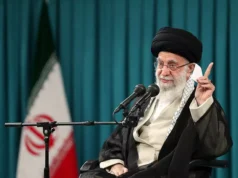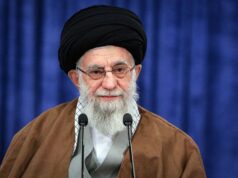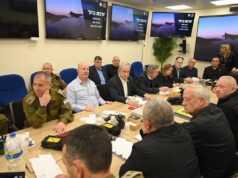In the aftermath of the September 11, 2001 attacks, the US began a series of military actions mostly involved with removing nasty governments and failing to replace them with anything competent – Iraq, Libya, Yemen, and Egypt, plus the Obama administration halfheartedly tried to knock off Bashar Assad in Syria.
From then until 2016, our government did not hold a serious conversation about American strategic interests. Now, it appears, we are. For this, President Trump is due some kudos, although I could argue with the method.
What are America’s strategic interests and how can we bolster them? The first and most general way to look at them is to say, your allies should feel safe, your adversaries should be worried, and for those who are neither, the allies camp should look better than the adversaries camp.
The second it to play a mind-game with the map. [Do China]
Now, turn to the Middle East, where the Shiite religious government is seeking an empire, using a relatively few troops, a large series of proxies creating instability across HUGE swaths of territory.
For decades, the concept of a “Shiite Crescent” anchored by the radical Shiite supremacists in Iran and passing through Iraq, Syria, and Hezb’allah to the Mediterranean Sea has been understood. It would provide Iran not only with closer access to Israel, but also spread across the northern borders of two key Sunni adversaries — pro-American Jordan, and its most important enemy, Saudi Arabia, guardian of Mecca and Medina. It would further split off Sunni Turkey (a historic foe) from the other Sunni Middle East states.
The Crescent is, for Iran, a single battlefront and the Islamic Republic has spent decades successfully undermining and wrecking each subsidiary member.
- Iraq is hardly a functional country. But as a staging ground for Iranian militias and weapons depots headed west, Iraq is a prize.
- Syria is largely a dead zone. But as a launching pad for Iranian military bases and attacks on Israel, Syria is a bonanza.
- Lebanon is a corrupt satrap of Syria and Iran, governed by a terror organization with a foreign legion and an international money/drug/weapons racket. But its very weakness and its border with Israel make Lebanon invaluable.
Each member of this “gang of four” maintains a state of war with Israel and threatens it on a regular basis. Israel’s attacks on weapons centers Lebanon, Syria and Iraq are not an escalation of a fragile situation — they are a defensive response to a high-tech military buildup orchestrated by Iran across the region.
Sunni Hamas and Shiite Palestinian Islamic Jihad were both recipients of Iranian funds, weapons, and training to harass Israel.
The underside Crescent, less well-understood, encircles the Gulf States and Saudi Arabia in the Gulf of Aden with a base in Yemen and a Houthi proxy at the bottom of the Red Sea, threatening the Bab el Mandeb Straits and the exit of Israel, Jordan, Egypt and Saudi Arabia to the Gulf and the Indian Ocean. And the American base in Djibouti.
And Africa. Iran incubated Sunni jihadists in the poor, corrupt, and vulnerable states of the second tier – Sudan, Chad, Niger, and Mali. The result was waves of migrants headed north. The North African countries – Egypt. Libya, Tunisia, Morocco and Algeria – were all in the NATO Mediterranean Dialogue group that helped control safety and security in the sea until the Obama Administration toppled the Libyan government in 2011. Libya, no longer a member of the Dialogue, has become a hole in the dam through which hundreds of thousands of African migrants reached Europe from south to north and east to west.
Imperial overreach was the ruin of the Roman Empire, the Byzantines, Egyptians, Ottomans, Nazis, and Soviets. Could it be catching up with Iran? Wait, you say, Iran isn’t an empire. Not in the traditional sense. But, as I said, it was always the belief of the hegemonic Mullahs that instability across large regions, managed with a relatively small group of well-trained Iranian professionals and a lot of proxy fighters, would create a world in which Shiite supremacism held sway.
And it was working. But has the empire reached too far?
American-led sanctions against Iran have been an enormous financial blow to the Mullahs, but sanctions are misunderstood. Not a mechanism for toppling a government, they are a means of forcing a government to make choices – between, let’s say, revolution and agriculture; between weapons and water and sewer systems; between Palestinian jihadists and schools. That is what Iran faced in 2011 and that is what led to the Iran/P5+1 negotiations. The fact that President Obama collapsed and paid off the Mullahs, allowed them to avoid those very choices and set back the operation by years and millions of deaths in the Middle East and Africa.
The restoration of sanctions by the Trump administration means Iran has less to pay off its proxies – as well as less for its own people. European business, and even China, are leaving Iran and taking their money. Iran tried to compensate by stealing Iraqi oil.
As Iran spreads its tentacles abroad and builds its illegal nuclear capability, it is clear that regime cannot fund domestic priorities and international revolution on the same budget – especially as that budget contracts.
Since December 2017, a sort of “rolling rebellion” has been occurring across Iran. It is bigger, deeper and stronger than the Green Revolution of 2009 and taking place in great measure outside Tehran, where the population is more diverse. There have been strikes of truckers, bazaar shopkeepers, teachers, farmers, and students. See #WhiteWednesday on Twitter to watch brave Iranian women go into the streets and take off their head coverings. Sometimes they dance. Sometimes their husbands, fathers, and brothers go with them. Sometimes they are arrested and sometimes they go to jail. Unfortunately, it took the suicide of a young woman facing seven years in prison for attending a soccer match to get the attention of the Western press.
In May of this year, widespread upheaval convulsed the country and thousands were arrested. Videos, presumably from cell phones, show that pictures of the Ayatollah Khameini have been set on fire and demonstrators are chanting “Death to the Dictator” and “Death to Rouhani.”
In Lebanon and in Iraq, millennials have taken to the streets to protest their respective governments. It stands to reason — in both countries, services are minimal, jobs are non-existent, and the best way to make a living is to leave. Garbage piles up in the streets of Beirut and forest fires have decimated the country. In Iraq, corruption is endemic. But in both countries, there is more afoot.
The demonstrators, representing a variety of religious and ethnic groups in countries that have been wracked by sectarian fighting, agree that the presence of Iran and its proxies in their homelands has deformed politics and economics alike.
Young people want Iran out.
Association with the Islamic Republic means that assets are taken and used by the Islamic Revolutionary Guard Corps, not by the civilian government, and it means religious and ethnic tensions are stoked to ensure that a unified public cannot impede Iran’s regional ambitions. Iran wants Iraq for the oil and also for the passageway through Sunni territory to Syria, Lebanon, and the Mediterranean Sea. It helped create the instability of ISIS in Iraq by “offering” to help contain the threat via Shiite militias commanded by Iranian officers. Those Shiite militias remain in the largely Sunni western part of Iraq and in the Kurdish areas.
The story in Lebanon goes back farther — to the early days of the Islamic Republic. Iran created Hezbollah and had its hand in the 1982 Marine barracks bombing that killed 244 Americans. It fostered and enlarged Hezbollah and planted an arsenal of rockets and missiles in southern Lebanon (in violation of U.N. Resolution 1701) and missile factories closer to Beirut. Lebanese civilians live between the Iranian/Hezbollah arsenal and potential Israeli retaliation if that arsenal is used.
Permanent revolution, permanent warfare, permanent upheaval — stoked by an outside force — makes it impossible to create the workable, modern, growing economy millennials demand; particularly in Lebanon, where there is a well-educated generation that crosses sectarian divides.
And now – we come to now
Iranian Revolutionary Guard Corps (IRGC) Qods Force Commander Qassem Soleimani is no more. He died with the blood of tens of thousands of people on his hands — Americans, Syrians, Kurds, Israelis, Lebanese, Iraqis, Pakistanis, Afghans, Africans in Nigeria, Chad, Mali, and more. He was an enemy combatant of the United States and leader of a U.S.-designated Foreign Terrorist Organization.
It is tempting just to say, “yippie” and move on. But the extraordinary number of people — including Americans, including The New York Times, including House Speaker Nancy Pelosi (D-CA) and Senate Minority Leader Chuck Schumer (D-NY) — disapproving of President Donald Trump’s decision to have our military skillfully dispatch Soleimani to wherever he’s gone requires more comment.
The Times began its story with, “Mr. Trump’s decision to kill General Soleimani was one that Presidents George W. Bush and Barack Obama had rejected, fearing it would lead to war.” The Times makes the fundamental mistake: Nothing the United States does will “lead to war.” The war is already 40 years old — we just haven’t been fighting it much.
Iran declared real and operational war on the United States (and Israel) at the onset of the Islamic Republic in 1979. From the U.S. embassy takeover in ‘79 to the Beirut Marine Barracks bombing in 1983 to the attacks against American troops in Iraq to the bomb plots against the Saudi ambassador in Washington and the Israeli embassy in 2011 to the capture of American naval personnel in 2016 (and major violations of the Americans’ Geneva Convention rights) to the continuing Iranian harassment of U.S. shipping in the Persian Gulf and Bab-el-Mandeb Straits, Iran has killed Americans and threatened to kill more.
Soleimani was head of the Iranian militias that killed 608 American soldiers in Iraq and maimed thousands of others through the use of IEDs. He armed, trained, and commanded the Iraqi militia Kataib Hezbollah that was responsible for the killing of an American contractor in Iraq and the injuring of several American soldiers — and for attacking the U.S. embassy in Baghdad, which directly precipitated the current situation.
And that’s only about the United States. Soleimani’s IRGC-controlled militias sent tens of thousands of troops, mostly Pakistani and Afghan, to Syria to commit large-scale ethnic cleansing of Syrian Sunnis and precipitating the Syrian refugee crisis in Europe. Soleimani’s IRGC-controlled militias ostensibly fought against ISIS in western Iraq, but committed a variety of crimes against Iraqi Sunni civilians there, as well. The arming of Hezbollah in Lebanon with precision missiles, now aimed at Israel, is a Soleimani-led IRGC operation. The establishment of Iranian missile factories in Lebanon, Syria, and Iraq is a Soleimani-led IRGC operation.
Some are condemning the elimination of Soleimani out of fear of the retaliation that Iran might try to exact. Those people aren’t actually wrong. But if they believe the United States should ignore Iranian provocation or abandon the Middle East to protect ourselves here at home — it’s too late for that.
Just last month, Ali Hourani, an American citizen, was sentenced to 40 years in federal prison for “helping Hezbollah and Iran prepare to strike strategic and vulnerable targets around New York City, such as federal facilities housing day care centers, critical infrastructure, counterterrorism command posts, and international airports, as well as members of the NYPD, the Mossad, and the Israel Defense Forces,” according to the federal sentencing memo.
Anything Hezbollah knows, Iran knows.
That, however, is less a reason to condemn the elimination of Soleimani than to understand the breadth and depth of the war Iran has long been waging. The present escalation of that war is a sign that the Iranian empire has overreached, is collapsing, and needs a “victory” against the mullahs’ “Great Satan” (U.S.) or the “Little Satan” (Israel) to justify its continued existence.
Enemies are most dangerous when they see their demise on the horizon — the Battle of the Bulge was Hitler’s way of ensuring the greatest number of allied casualties before the end of the Nazi empire. That appears to be where Iran is now, that is why the dispatch of Soleimani was essential, and that is why Americans and our allies must present a united front against Iran.
Our Western heritage — not so much electoral politics, but free speech, rule of law, free-market economics, independent judiciaries, property rights, and tolerance — is, in fact, responsive to the economic and social conditions confronted by people across the Middle East and North Africa. It is not arrogance to say so.
But they will have to choose it themselves – we cannot impose it on them. On the other hand, they have no ability to choose it if Iran occupies their countries.
That is the conversation we’re going to have – whether we like it or not.






